Detailed Project Management Case Study: Music Festival Organization
VerifiedAdded on 2023/01/12
|13
|2172
|36
Project
AI Summary
This project management case study analyzes the organization of a music festival, encompassing various project management techniques. The study begins with an executive summary and an introduction, followed by a discussion of three project management methodologies: Waterfall, PRINCE2, and Scrum. Task 2 focuses on PERT/CPM diagrams, critical path analysis, and the calculation of EST, LST, EFT, and LFT. Task 3 involves stakeholder analysis and the creation of a Work Breakdown Structure (WBS). Finally, Task 4 addresses risk management strategies to mitigate potential challenges. The case study provides a comprehensive overview of project planning, execution, and control within the context of a music festival, supported by references to relevant literature.
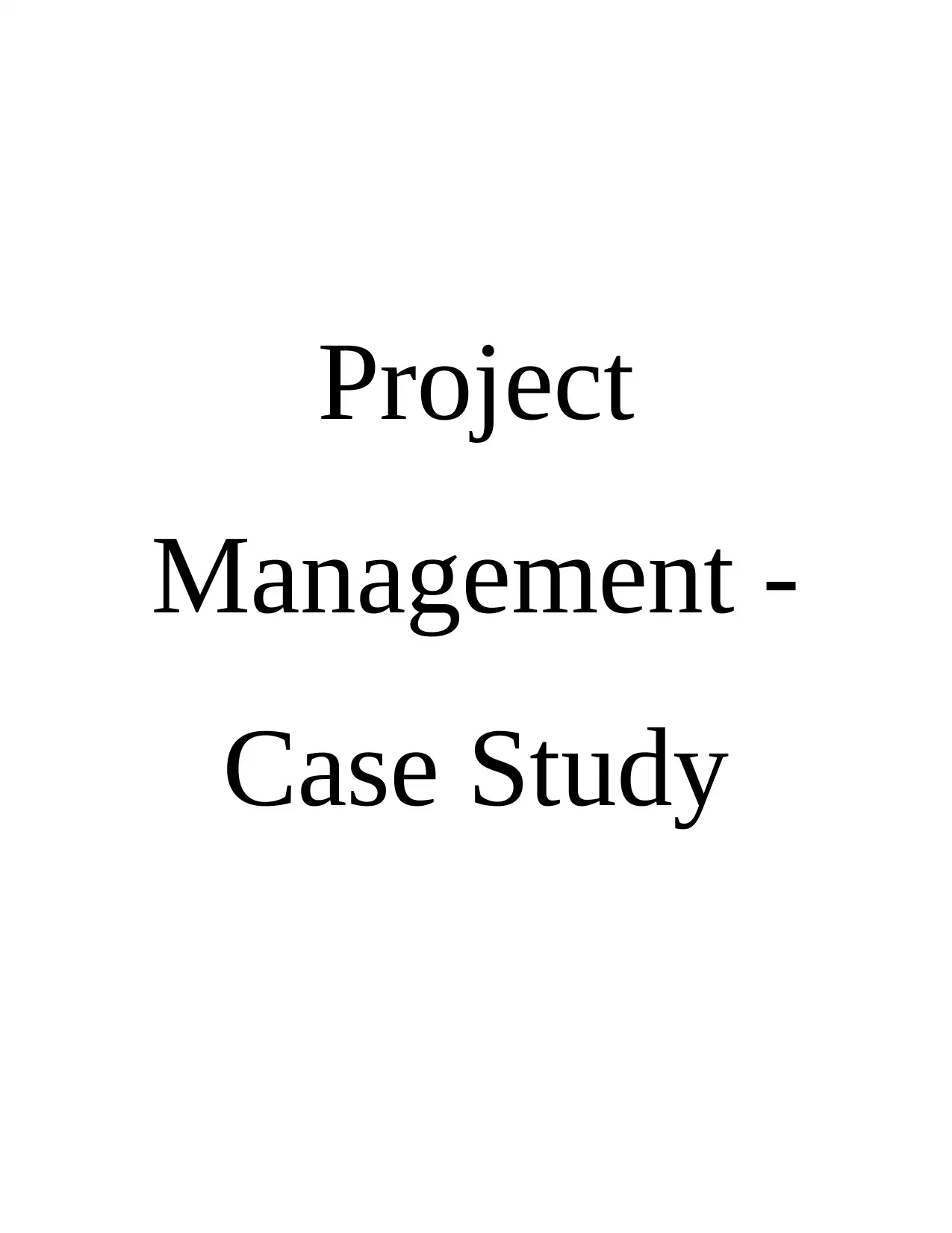
Project
Management -
Case Study
Management -
Case Study
Paraphrase This Document
Need a fresh take? Get an instant paraphrase of this document with our AI Paraphraser
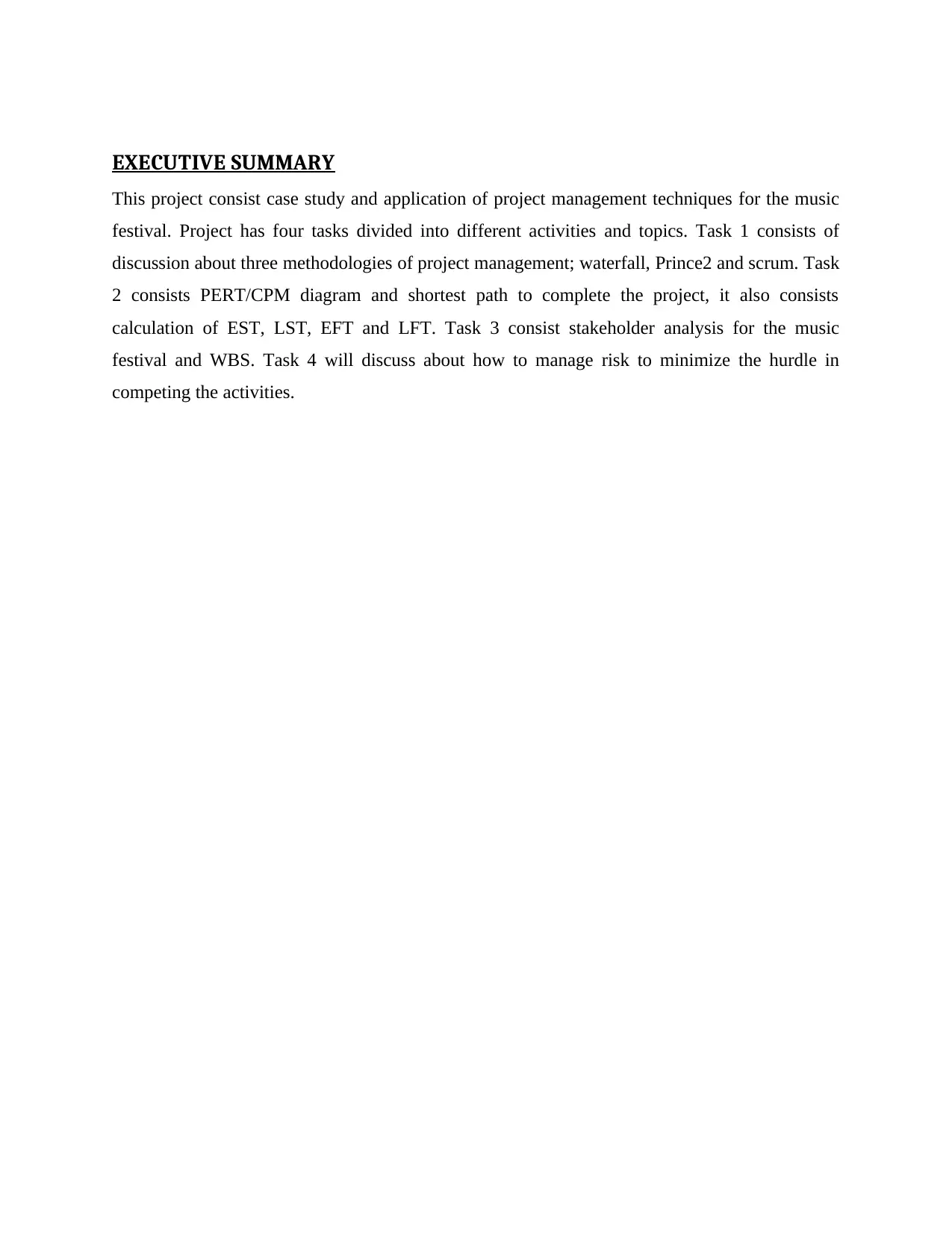
EXECUTIVE SUMMARY
This project consist case study and application of project management techniques for the music
festival. Project has four tasks divided into different activities and topics. Task 1 consists of
discussion about three methodologies of project management; waterfall, Prince2 and scrum. Task
2 consists PERT/CPM diagram and shortest path to complete the project, it also consists
calculation of EST, LST, EFT and LFT. Task 3 consist stakeholder analysis for the music
festival and WBS. Task 4 will discuss about how to manage risk to minimize the hurdle in
competing the activities.
This project consist case study and application of project management techniques for the music
festival. Project has four tasks divided into different activities and topics. Task 1 consists of
discussion about three methodologies of project management; waterfall, Prince2 and scrum. Task
2 consists PERT/CPM diagram and shortest path to complete the project, it also consists
calculation of EST, LST, EFT and LFT. Task 3 consist stakeholder analysis for the music
festival and WBS. Task 4 will discuss about how to manage risk to minimize the hurdle in
competing the activities.
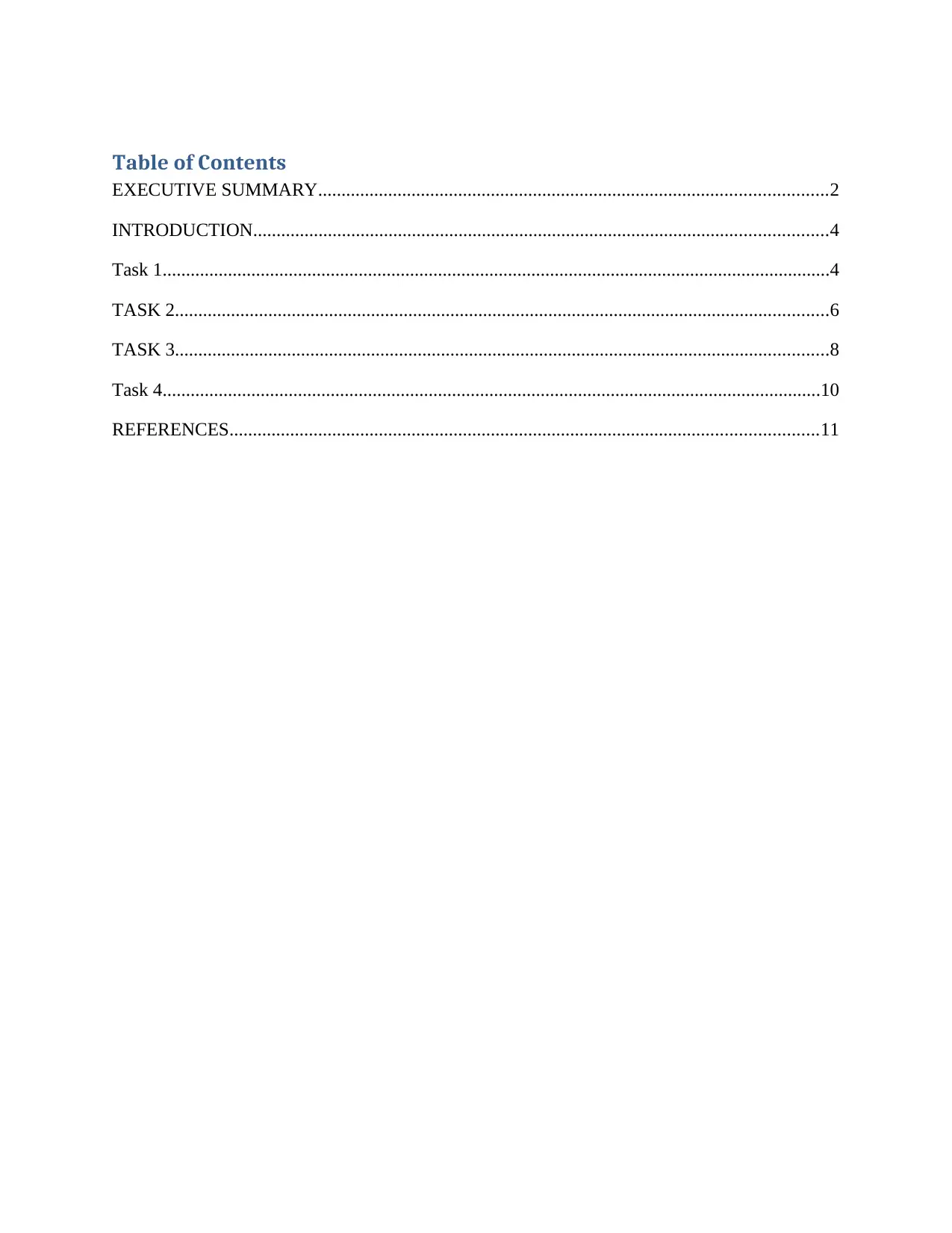
Table of Contents
EXECUTIVE SUMMARY.............................................................................................................2
INTRODUCTION...........................................................................................................................4
Task 1...............................................................................................................................................4
TASK 2............................................................................................................................................6
TASK 3............................................................................................................................................8
Task 4.............................................................................................................................................10
REFERENCES..............................................................................................................................11
EXECUTIVE SUMMARY.............................................................................................................2
INTRODUCTION...........................................................................................................................4
Task 1...............................................................................................................................................4
TASK 2............................................................................................................................................6
TASK 3............................................................................................................................................8
Task 4.............................................................................................................................................10
REFERENCES..............................................................................................................................11
⊘ This is a preview!⊘
Do you want full access?
Subscribe today to unlock all pages.

Trusted by 1+ million students worldwide
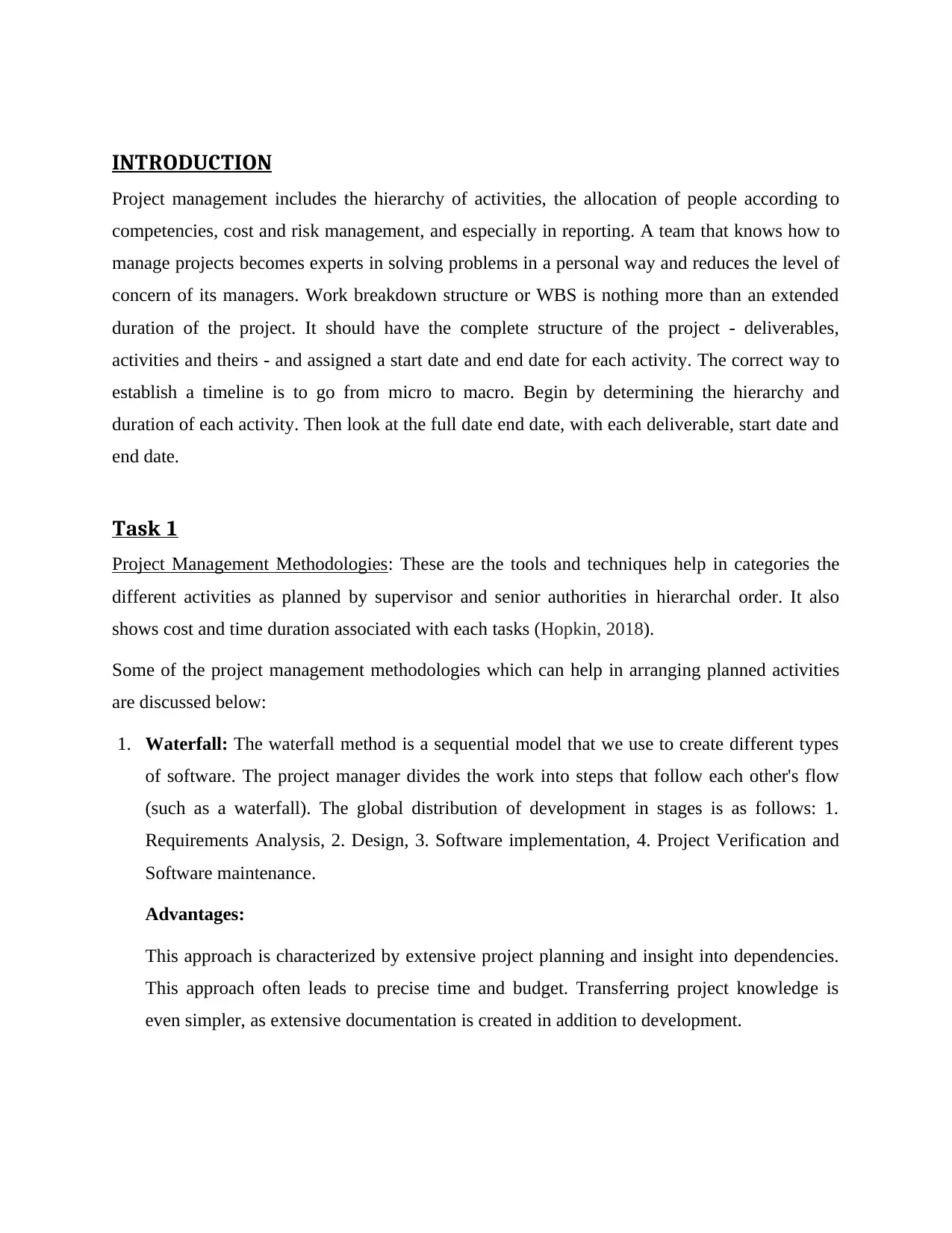
INTRODUCTION
Project management includes the hierarchy of activities, the allocation of people according to
competencies, cost and risk management, and especially in reporting. A team that knows how to
manage projects becomes experts in solving problems in a personal way and reduces the level of
concern of its managers. Work breakdown structure or WBS is nothing more than an extended
duration of the project. It should have the complete structure of the project - deliverables,
activities and theirs - and assigned a start date and end date for each activity. The correct way to
establish a timeline is to go from micro to macro. Begin by determining the hierarchy and
duration of each activity. Then look at the full date end date, with each deliverable, start date and
end date.
Task 1
Project Management Methodologies: These are the tools and techniques help in categories the
different activities as planned by supervisor and senior authorities in hierarchal order. It also
shows cost and time duration associated with each tasks (Hopkin, 2018).
Some of the project management methodologies which can help in arranging planned activities
are discussed below:
1. Waterfall: The waterfall method is a sequential model that we use to create different types
of software. The project manager divides the work into steps that follow each other's flow
(such as a waterfall). The global distribution of development in stages is as follows: 1.
Requirements Analysis, 2. Design, 3. Software implementation, 4. Project Verification and
Software maintenance.
Advantages:
This approach is characterized by extensive project planning and insight into dependencies.
This approach often leads to precise time and budget. Transferring project knowledge is
even simpler, as extensive documentation is created in addition to development.
Project management includes the hierarchy of activities, the allocation of people according to
competencies, cost and risk management, and especially in reporting. A team that knows how to
manage projects becomes experts in solving problems in a personal way and reduces the level of
concern of its managers. Work breakdown structure or WBS is nothing more than an extended
duration of the project. It should have the complete structure of the project - deliverables,
activities and theirs - and assigned a start date and end date for each activity. The correct way to
establish a timeline is to go from micro to macro. Begin by determining the hierarchy and
duration of each activity. Then look at the full date end date, with each deliverable, start date and
end date.
Task 1
Project Management Methodologies: These are the tools and techniques help in categories the
different activities as planned by supervisor and senior authorities in hierarchal order. It also
shows cost and time duration associated with each tasks (Hopkin, 2018).
Some of the project management methodologies which can help in arranging planned activities
are discussed below:
1. Waterfall: The waterfall method is a sequential model that we use to create different types
of software. The project manager divides the work into steps that follow each other's flow
(such as a waterfall). The global distribution of development in stages is as follows: 1.
Requirements Analysis, 2. Design, 3. Software implementation, 4. Project Verification and
Software maintenance.
Advantages:
This approach is characterized by extensive project planning and insight into dependencies.
This approach often leads to precise time and budget. Transferring project knowledge is
even simpler, as extensive documentation is created in addition to development.
Paraphrase This Document
Need a fresh take? Get an instant paraphrase of this document with our AI Paraphraser
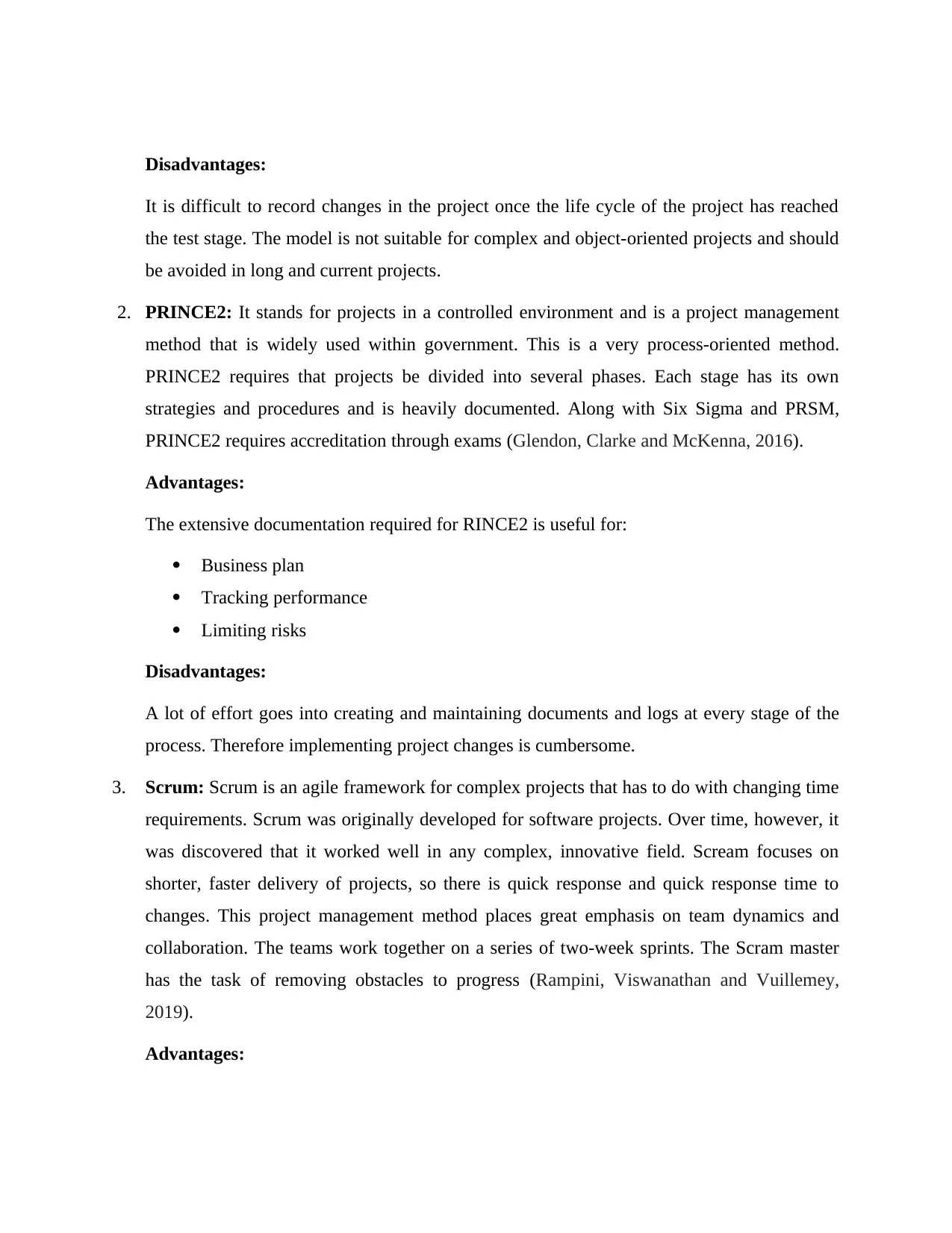
Disadvantages:
It is difficult to record changes in the project once the life cycle of the project has reached
the test stage. The model is not suitable for complex and object-oriented projects and should
be avoided in long and current projects.
2. PRINCE2: It stands for projects in a controlled environment and is a project management
method that is widely used within government. This is a very process-oriented method.
PRINCE2 requires that projects be divided into several phases. Each stage has its own
strategies and procedures and is heavily documented. Along with Six Sigma and PRSM,
PRINCE2 requires accreditation through exams (Glendon, Clarke and McKenna, 2016).
Advantages:
The extensive documentation required for RINCE2 is useful for:
Business plan
Tracking performance
Limiting risks
Disadvantages:
A lot of effort goes into creating and maintaining documents and logs at every stage of the
process. Therefore implementing project changes is cumbersome.
3. Scrum: Scrum is an agile framework for complex projects that has to do with changing time
requirements. Scrum was originally developed for software projects. Over time, however, it
was discovered that it worked well in any complex, innovative field. Scream focuses on
shorter, faster delivery of projects, so there is quick response and quick response time to
changes. This project management method places great emphasis on team dynamics and
collaboration. The teams work together on a series of two-week sprints. The Scram master
has the task of removing obstacles to progress (Rampini, Viswanathan and Vuillemey,
2019).
Advantages:
It is difficult to record changes in the project once the life cycle of the project has reached
the test stage. The model is not suitable for complex and object-oriented projects and should
be avoided in long and current projects.
2. PRINCE2: It stands for projects in a controlled environment and is a project management
method that is widely used within government. This is a very process-oriented method.
PRINCE2 requires that projects be divided into several phases. Each stage has its own
strategies and procedures and is heavily documented. Along with Six Sigma and PRSM,
PRINCE2 requires accreditation through exams (Glendon, Clarke and McKenna, 2016).
Advantages:
The extensive documentation required for RINCE2 is useful for:
Business plan
Tracking performance
Limiting risks
Disadvantages:
A lot of effort goes into creating and maintaining documents and logs at every stage of the
process. Therefore implementing project changes is cumbersome.
3. Scrum: Scrum is an agile framework for complex projects that has to do with changing time
requirements. Scrum was originally developed for software projects. Over time, however, it
was discovered that it worked well in any complex, innovative field. Scream focuses on
shorter, faster delivery of projects, so there is quick response and quick response time to
changes. This project management method places great emphasis on team dynamics and
collaboration. The teams work together on a series of two-week sprints. The Scram master
has the task of removing obstacles to progress (Rampini, Viswanathan and Vuillemey,
2019).
Advantages:
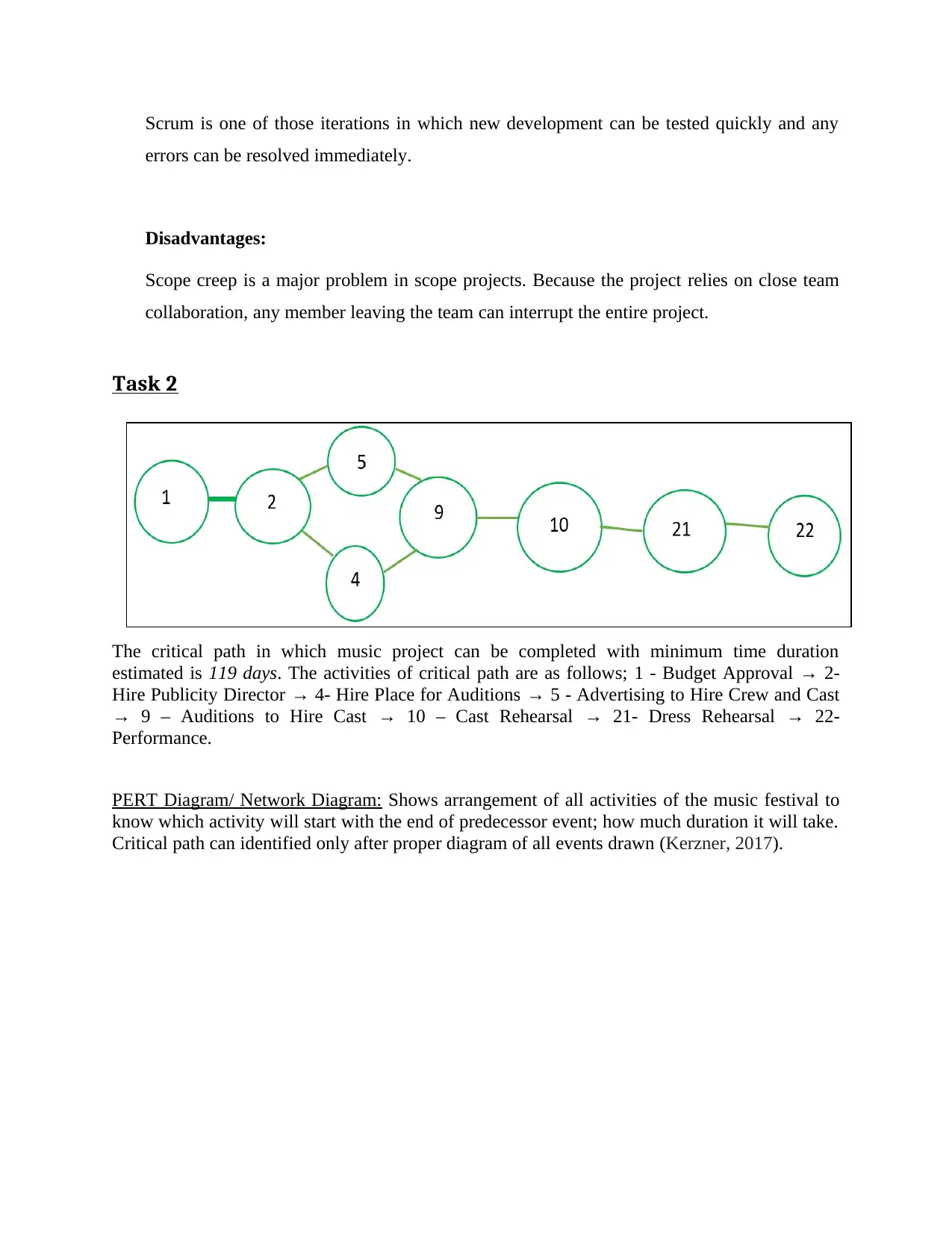
Scrum is one of those iterations in which new development can be tested quickly and any
errors can be resolved immediately.
Disadvantages:
Scope creep is a major problem in scope projects. Because the project relies on close team
collaboration, any member leaving the team can interrupt the entire project.
Task 2
The critical path in which music project can be completed with minimum time duration
estimated is 119 days. The activities of critical path are as follows; 1 - Budget Approval → 2-
Hire Publicity Director → 4- Hire Place for Auditions → 5 - Advertising to Hire Crew and Cast
→ 9 – Auditions to Hire Cast → 10 – Cast Rehearsal → 21- Dress Rehearsal → 22-
Performance.
PERT Diagram/ Network Diagram: Shows arrangement of all activities of the music festival to
know which activity will start with the end of predecessor event; how much duration it will take.
Critical path can identified only after proper diagram of all events drawn (Kerzner, 2017).
errors can be resolved immediately.
Disadvantages:
Scope creep is a major problem in scope projects. Because the project relies on close team
collaboration, any member leaving the team can interrupt the entire project.
Task 2
The critical path in which music project can be completed with minimum time duration
estimated is 119 days. The activities of critical path are as follows; 1 - Budget Approval → 2-
Hire Publicity Director → 4- Hire Place for Auditions → 5 - Advertising to Hire Crew and Cast
→ 9 – Auditions to Hire Cast → 10 – Cast Rehearsal → 21- Dress Rehearsal → 22-
Performance.
PERT Diagram/ Network Diagram: Shows arrangement of all activities of the music festival to
know which activity will start with the end of predecessor event; how much duration it will take.
Critical path can identified only after proper diagram of all events drawn (Kerzner, 2017).
⊘ This is a preview!⊘
Do you want full access?
Subscribe today to unlock all pages.

Trusted by 1+ million students worldwide
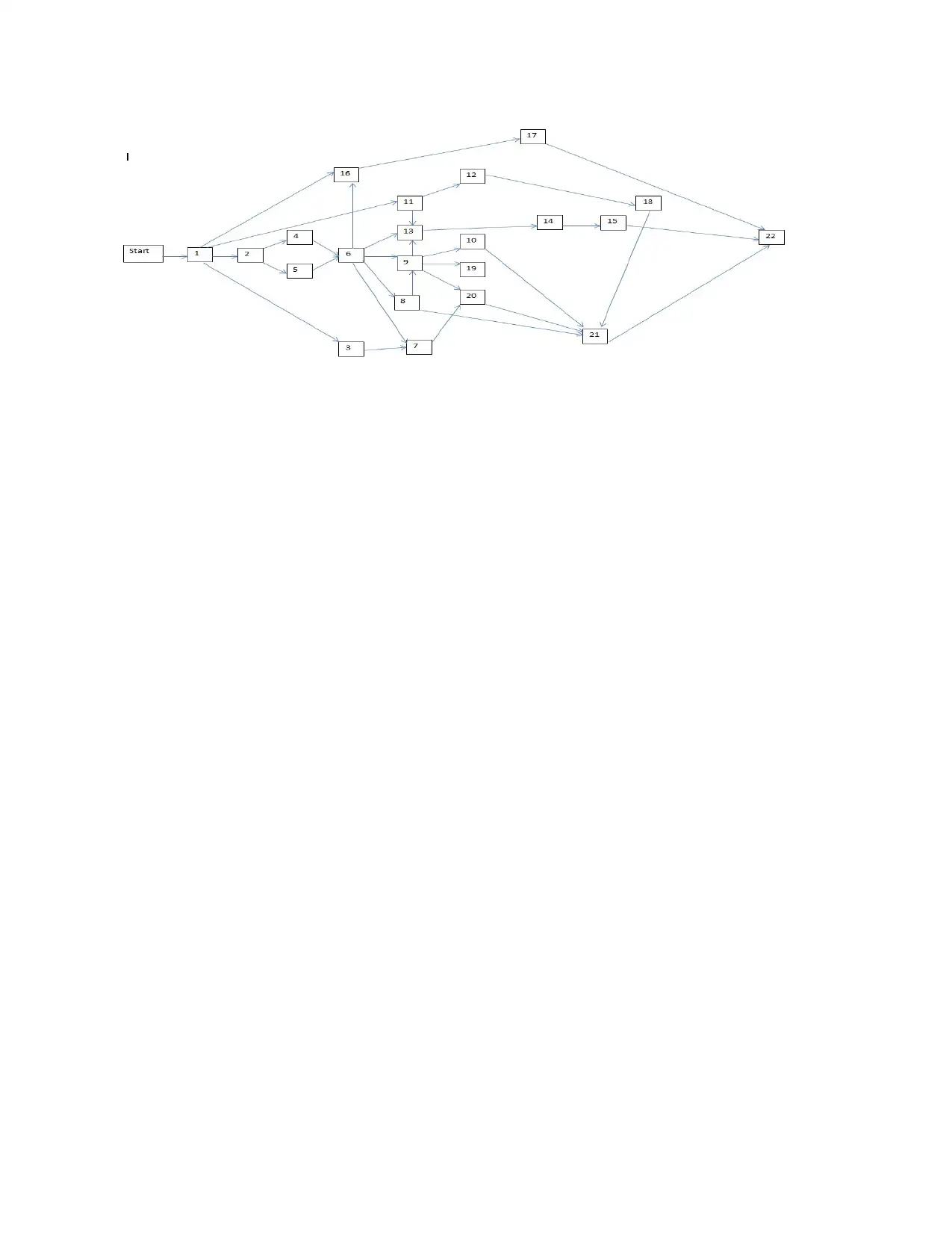
Paraphrase This Document
Need a fresh take? Get an instant paraphrase of this document with our AI Paraphraser
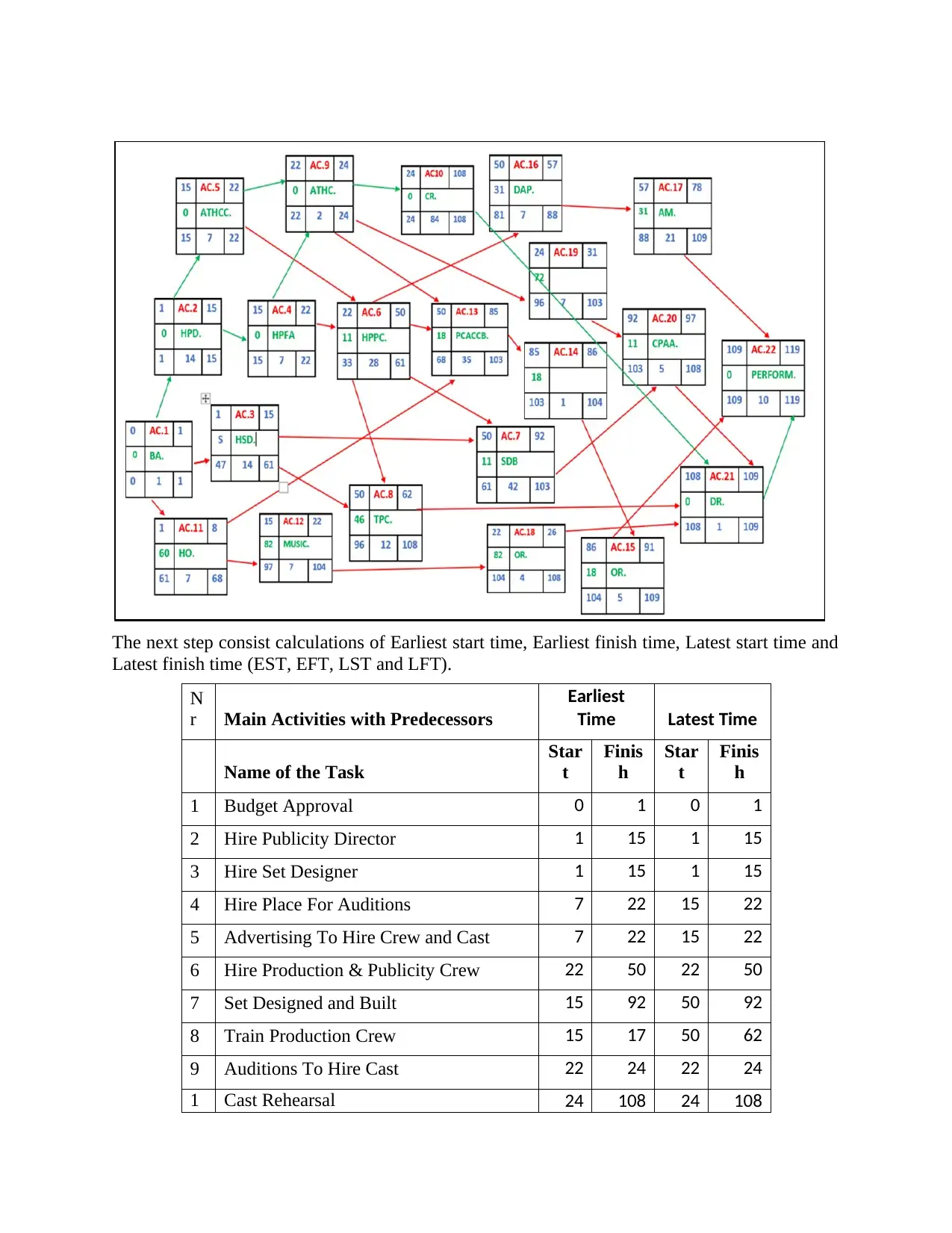
The next step consist calculations of Earliest start time, Earliest finish time, Latest start time and
Latest finish time (EST, EFT, LST and LFT).
N
r Main Activities with Predecessors
Earliest
Time Latest Time
Name of the Task
Star
t
Finis
h
Star
t
Finis
h
1 Budget Approval 0 1 0 1
2 Hire Publicity Director 1 15 1 15
3 Hire Set Designer 1 15 1 15
4 Hire Place For Auditions 7 22 15 22
5 Advertising To Hire Crew and Cast 7 22 15 22
6 Hire Production & Publicity Crew 22 50 22 50
7 Set Designed and Built 15 92 50 92
8 Train Production Crew 15 17 50 62
9 Auditions To Hire Cast 22 24 22 24
1 Cast Rehearsal 24 108 24 108
Latest finish time (EST, EFT, LST and LFT).
N
r Main Activities with Predecessors
Earliest
Time Latest Time
Name of the Task
Star
t
Finis
h
Star
t
Finis
h
1 Budget Approval 0 1 0 1
2 Hire Publicity Director 1 15 1 15
3 Hire Set Designer 1 15 1 15
4 Hire Place For Auditions 7 22 15 22
5 Advertising To Hire Crew and Cast 7 22 15 22
6 Hire Production & Publicity Crew 22 50 22 50
7 Set Designed and Built 15 92 50 92
8 Train Production Crew 15 17 50 62
9 Auditions To Hire Cast 22 24 22 24
1 Cast Rehearsal 24 108 24 108
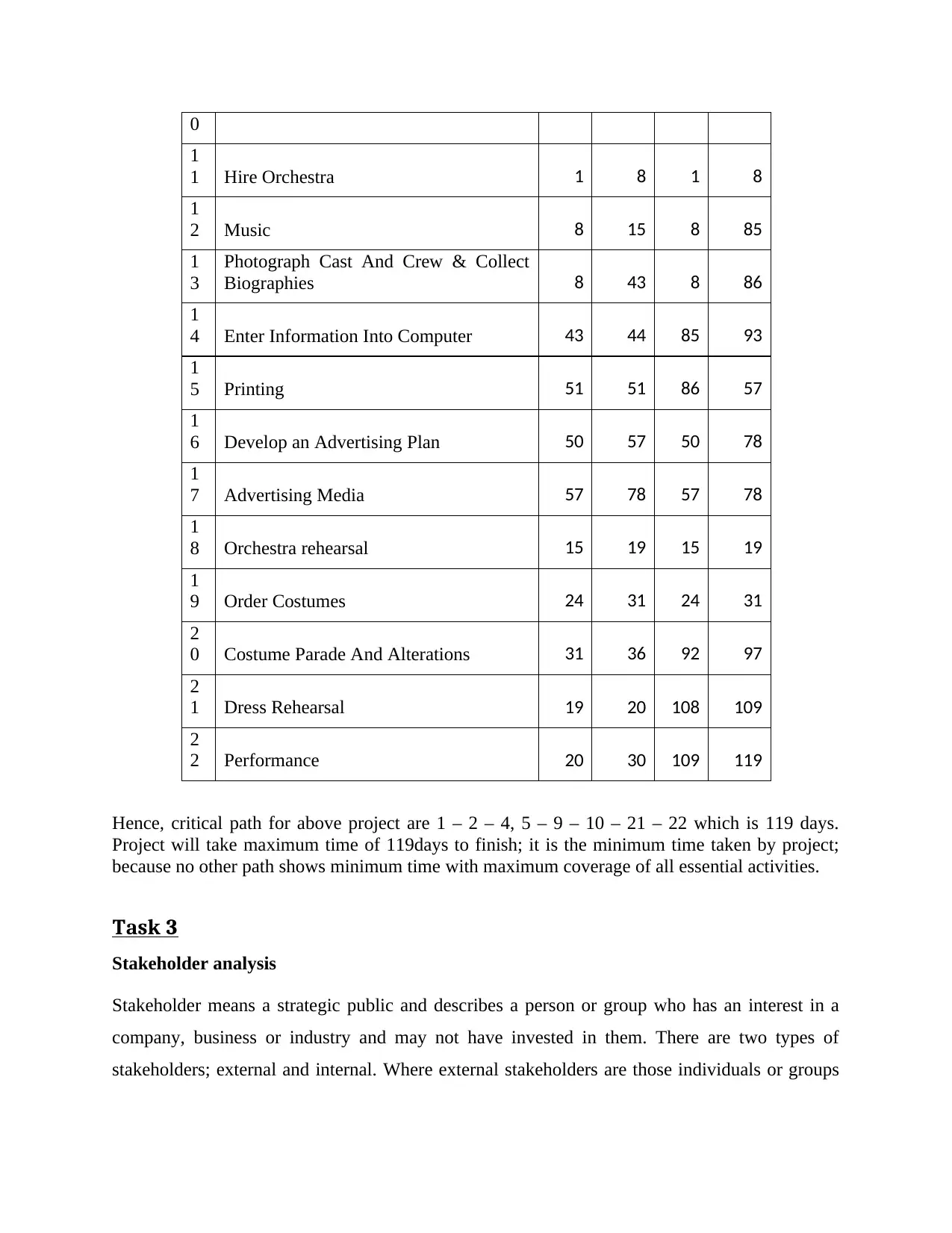
0
1
1 Hire Orchestra 1 8 1 8
1
2 Music 8 15 8 85
1
3
Photograph Cast And Crew & Collect
Biographies 8 43 8 86
1
4 Enter Information Into Computer 43 44 85 93
1
5 Printing 51 51 86 57
1
6 Develop an Advertising Plan 50 57 50 78
1
7 Advertising Media 57 78 57 78
1
8 Orchestra rehearsal 15 19 15 19
1
9 Order Costumes 24 31 24 31
2
0 Costume Parade And Alterations 31 36 92 97
2
1 Dress Rehearsal 19 20 108 109
2
2 Performance 20 30 109 119
Hence, critical path for above project are 1 – 2 – 4, 5 – 9 – 10 – 21 – 22 which is 119 days.
Project will take maximum time of 119days to finish; it is the minimum time taken by project;
because no other path shows minimum time with maximum coverage of all essential activities.
Task 3
Stakeholder analysis
Stakeholder means a strategic public and describes a person or group who has an interest in a
company, business or industry and may not have invested in them. There are two types of
stakeholders; external and internal. Where external stakeholders are those individuals or groups
1
1 Hire Orchestra 1 8 1 8
1
2 Music 8 15 8 85
1
3
Photograph Cast And Crew & Collect
Biographies 8 43 8 86
1
4 Enter Information Into Computer 43 44 85 93
1
5 Printing 51 51 86 57
1
6 Develop an Advertising Plan 50 57 50 78
1
7 Advertising Media 57 78 57 78
1
8 Orchestra rehearsal 15 19 15 19
1
9 Order Costumes 24 31 24 31
2
0 Costume Parade And Alterations 31 36 92 97
2
1 Dress Rehearsal 19 20 108 109
2
2 Performance 20 30 109 119
Hence, critical path for above project are 1 – 2 – 4, 5 – 9 – 10 – 21 – 22 which is 119 days.
Project will take maximum time of 119days to finish; it is the minimum time taken by project;
because no other path shows minimum time with maximum coverage of all essential activities.
Task 3
Stakeholder analysis
Stakeholder means a strategic public and describes a person or group who has an interest in a
company, business or industry and may not have invested in them. There are two types of
stakeholders; external and internal. Where external stakeholders are those individuals or groups
⊘ This is a preview!⊘
Do you want full access?
Subscribe today to unlock all pages.

Trusted by 1+ million students worldwide
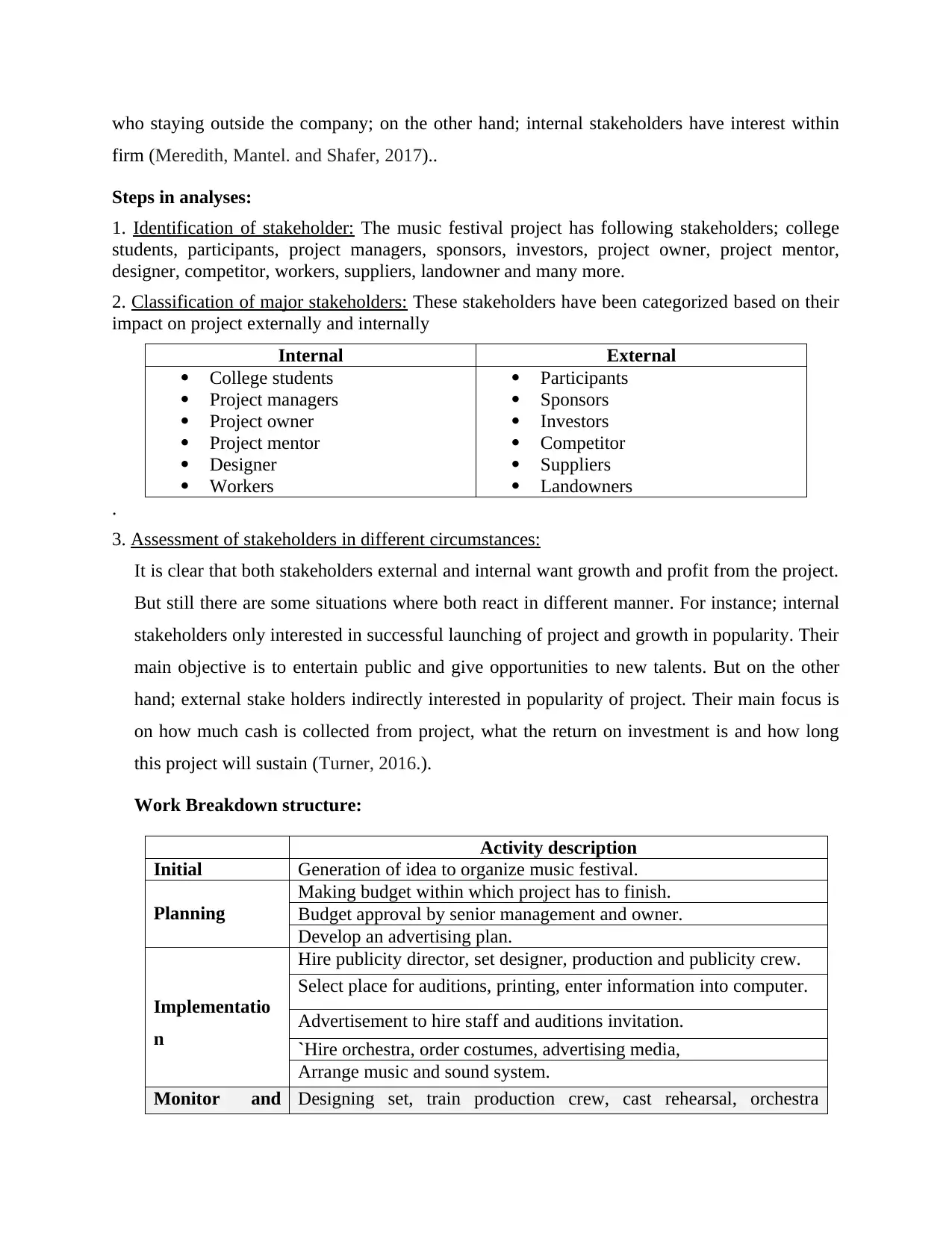
who staying outside the company; on the other hand; internal stakeholders have interest within
firm (Meredith, Mantel. and Shafer, 2017)..
Steps in analyses:
1. Identification of stakeholder: The music festival project has following stakeholders; college
students, participants, project managers, sponsors, investors, project owner, project mentor,
designer, competitor, workers, suppliers, landowner and many more.
2. Classification of major stakeholders: These stakeholders have been categorized based on their
impact on project externally and internally
Internal External
College students
Project managers
Project owner
Project mentor
Designer
Workers
Participants
Sponsors
Investors
Competitor
Suppliers
Landowners
.
3. Assessment of stakeholders in different circumstances:
It is clear that both stakeholders external and internal want growth and profit from the project.
But still there are some situations where both react in different manner. For instance; internal
stakeholders only interested in successful launching of project and growth in popularity. Their
main objective is to entertain public and give opportunities to new talents. But on the other
hand; external stake holders indirectly interested in popularity of project. Their main focus is
on how much cash is collected from project, what the return on investment is and how long
this project will sustain (Turner, 2016.).
Work Breakdown structure:
Activity description
Initial Generation of idea to organize music festival.
Planning
Making budget within which project has to finish.
Budget approval by senior management and owner.
Develop an advertising plan.
Implementatio
n
Hire publicity director, set designer, production and publicity crew.
Select place for auditions, printing, enter information into computer.
Advertisement to hire staff and auditions invitation.
`Hire orchestra, order costumes, advertising media,
Arrange music and sound system.
Monitor and Designing set, train production crew, cast rehearsal, orchestra
firm (Meredith, Mantel. and Shafer, 2017)..
Steps in analyses:
1. Identification of stakeholder: The music festival project has following stakeholders; college
students, participants, project managers, sponsors, investors, project owner, project mentor,
designer, competitor, workers, suppliers, landowner and many more.
2. Classification of major stakeholders: These stakeholders have been categorized based on their
impact on project externally and internally
Internal External
College students
Project managers
Project owner
Project mentor
Designer
Workers
Participants
Sponsors
Investors
Competitor
Suppliers
Landowners
.
3. Assessment of stakeholders in different circumstances:
It is clear that both stakeholders external and internal want growth and profit from the project.
But still there are some situations where both react in different manner. For instance; internal
stakeholders only interested in successful launching of project and growth in popularity. Their
main objective is to entertain public and give opportunities to new talents. But on the other
hand; external stake holders indirectly interested in popularity of project. Their main focus is
on how much cash is collected from project, what the return on investment is and how long
this project will sustain (Turner, 2016.).
Work Breakdown structure:
Activity description
Initial Generation of idea to organize music festival.
Planning
Making budget within which project has to finish.
Budget approval by senior management and owner.
Develop an advertising plan.
Implementatio
n
Hire publicity director, set designer, production and publicity crew.
Select place for auditions, printing, enter information into computer.
Advertisement to hire staff and auditions invitation.
`Hire orchestra, order costumes, advertising media,
Arrange music and sound system.
Monitor and Designing set, train production crew, cast rehearsal, orchestra
Paraphrase This Document
Need a fresh take? Get an instant paraphrase of this document with our AI Paraphraser

control rehearsal, dress rehearsal, costume parade and alterations,
photograph cast and crew and collect biographies.
Closer Performance
photograph cast and crew and collect biographies.
Closer Performance
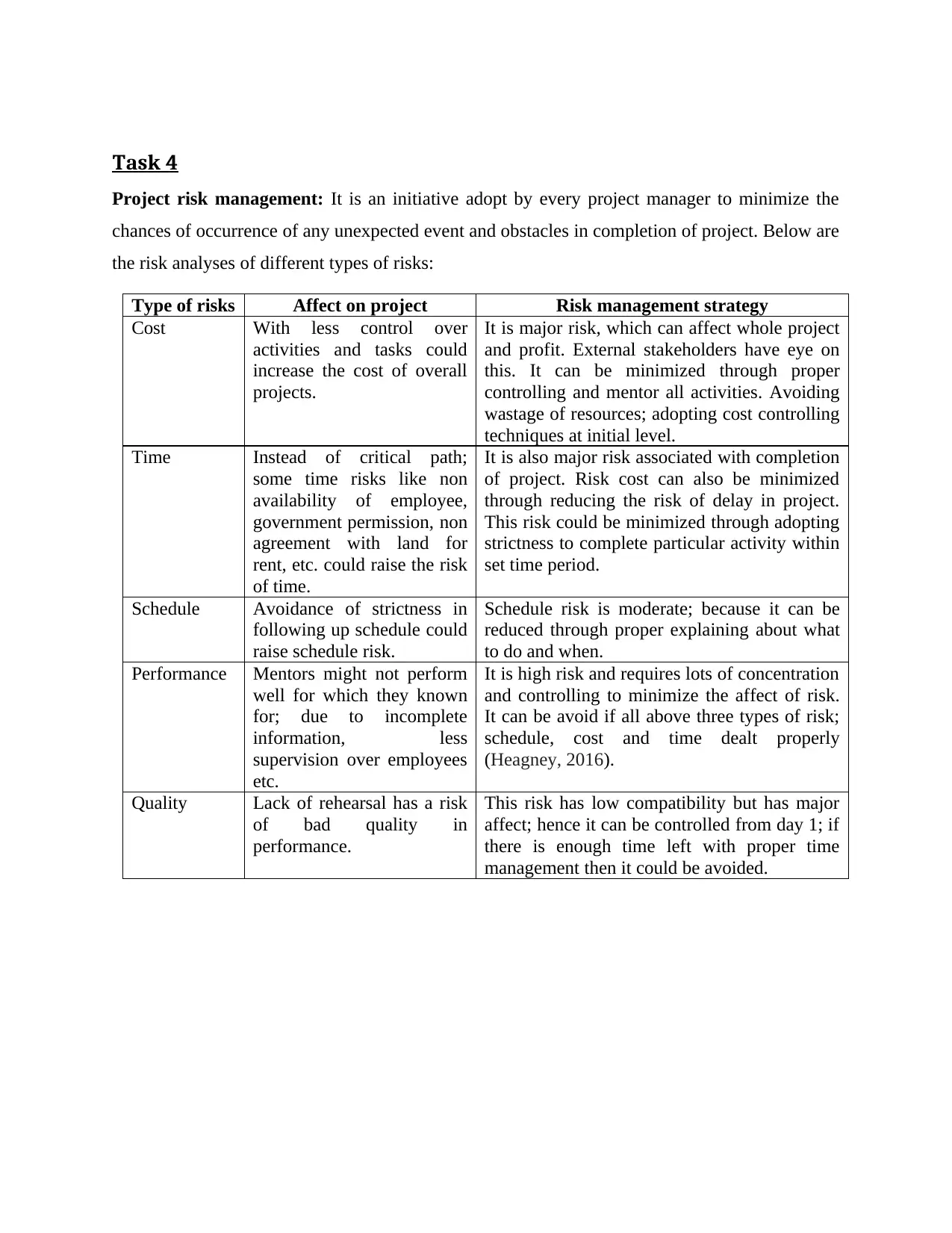
Task 4
Project risk management: It is an initiative adopt by every project manager to minimize the
chances of occurrence of any unexpected event and obstacles in completion of project. Below are
the risk analyses of different types of risks:
Type of risks Affect on project Risk management strategy
Cost With less control over
activities and tasks could
increase the cost of overall
projects.
It is major risk, which can affect whole project
and profit. External stakeholders have eye on
this. It can be minimized through proper
controlling and mentor all activities. Avoiding
wastage of resources; adopting cost controlling
techniques at initial level.
Time Instead of critical path;
some time risks like non
availability of employee,
government permission, non
agreement with land for
rent, etc. could raise the risk
of time.
It is also major risk associated with completion
of project. Risk cost can also be minimized
through reducing the risk of delay in project.
This risk could be minimized through adopting
strictness to complete particular activity within
set time period.
Schedule Avoidance of strictness in
following up schedule could
raise schedule risk.
Schedule risk is moderate; because it can be
reduced through proper explaining about what
to do and when.
Performance Mentors might not perform
well for which they known
for; due to incomplete
information, less
supervision over employees
etc.
It is high risk and requires lots of concentration
and controlling to minimize the affect of risk.
It can be avoid if all above three types of risk;
schedule, cost and time dealt properly
(Heagney, 2016).
Quality Lack of rehearsal has a risk
of bad quality in
performance.
This risk has low compatibility but has major
affect; hence it can be controlled from day 1; if
there is enough time left with proper time
management then it could be avoided.
Project risk management: It is an initiative adopt by every project manager to minimize the
chances of occurrence of any unexpected event and obstacles in completion of project. Below are
the risk analyses of different types of risks:
Type of risks Affect on project Risk management strategy
Cost With less control over
activities and tasks could
increase the cost of overall
projects.
It is major risk, which can affect whole project
and profit. External stakeholders have eye on
this. It can be minimized through proper
controlling and mentor all activities. Avoiding
wastage of resources; adopting cost controlling
techniques at initial level.
Time Instead of critical path;
some time risks like non
availability of employee,
government permission, non
agreement with land for
rent, etc. could raise the risk
of time.
It is also major risk associated with completion
of project. Risk cost can also be minimized
through reducing the risk of delay in project.
This risk could be minimized through adopting
strictness to complete particular activity within
set time period.
Schedule Avoidance of strictness in
following up schedule could
raise schedule risk.
Schedule risk is moderate; because it can be
reduced through proper explaining about what
to do and when.
Performance Mentors might not perform
well for which they known
for; due to incomplete
information, less
supervision over employees
etc.
It is high risk and requires lots of concentration
and controlling to minimize the affect of risk.
It can be avoid if all above three types of risk;
schedule, cost and time dealt properly
(Heagney, 2016).
Quality Lack of rehearsal has a risk
of bad quality in
performance.
This risk has low compatibility but has major
affect; hence it can be controlled from day 1; if
there is enough time left with proper time
management then it could be avoided.
⊘ This is a preview!⊘
Do you want full access?
Subscribe today to unlock all pages.

Trusted by 1+ million students worldwide
1 out of 13
Related Documents
Your All-in-One AI-Powered Toolkit for Academic Success.
+13062052269
info@desklib.com
Available 24*7 on WhatsApp / Email
![[object Object]](/_next/static/media/star-bottom.7253800d.svg)
Unlock your academic potential
Copyright © 2020–2025 A2Z Services. All Rights Reserved. Developed and managed by ZUCOL.





